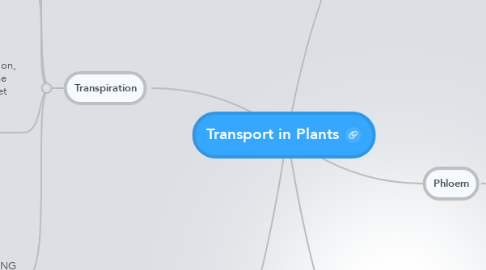
1. Manufactured Food Substances
1.1. Transported as sucrose and amino acids
1.2. Translocation is an active process that requires energy (Not fully understood)
2. Movement of water
2.1. Water enters the plant through the roots through osmosis
2.2. Cell sap in root hair has lower water potential than the surrounding soil solution. Therefore, water has to enter through osmosis (water flow from higher water potential to lower water potential)
2.3. Water passes by osmosis from the root hair cell to the inner cells.
2.4. This process continues until the water reaches the xylem vessels to be transported throughout the plant
3. Xylem
3.1. Structure
3.1.1. Walls made of lignin
3.1.2. Consists of mainly vessels
3.1.2.1. It has pits which allow water and dissolved minerals to be transported sideways to other cells.
3.1.3. Stretches from roots to leaves
3.2. Adaptations
3.2.1. It has lignified walls to support the plant
3.2.2. It has a hollow lumen with no cross walls to let water pass through it easily
3.2.3. It is a dead structure with no protoplasm (hollow lumen)
3.3. Functions
3.3.1. Provide mechanical support for the plant
3.3.2. Transport water from the roots to the rest of the plant
4. Transpiration
4.1. Means: Loss of water vapour from aerial parts of the plant, especially through the stomata of the leaves
4.2. Dependent upon evaporation.
4.3. Factors affecting Transpiration
4.3.1. Humidity of air
4.3.1.1. More Humid, slower rate of transpiration
4.3.2. Temperature of air
4.3.2.1. Higher temperature -> increases rate of evaporation of water vapor -> Transpiration is greater
4.3.3. Strong Wind
4.3.3.1. Stronger Wind, higher rate of transpiration
4.3.4. Light
4.3.4.1. Affects the size of stomata -> presence of light = increase of transpiration
4.4. Transpiration Pull: As a result of transpiration, water moves up the whole column from the roots to the leaf. This is also how water get transported up the plant. The plant has to loose water to gain water.
4.5. Importance of transpiration : WILTING
4.5.1. What is wilting?
4.5.1.1. Leaf folds up because of excessive loss of water
4.5.2. Advantages
4.5.2.1. Rate of transpiration reduced
4.5.2.1.1. Leaf folds up to reduce surface exposed to sunlight
4.5.2.2. Causes guard cells to become flaccid (stomata will close) - to prevent water lost
4.5.3. Disadvantages
4.5.3.1. Rate of photosynthesis is reduced
4.5.3.1.1. Water becomes a limiting factor
4.5.3.1.2. Closed stomata cause the amount of carbon dioxide entering the leaf to reduce.
5. Phloem
5.1. Adaptations
5.1.1. Holes in the sieve plates allows flow of the food substance (mainly sucrose) through sieve tube cells.
5.2. Functions
5.2.1. Transports food from the leaves to rest of the plant
5.2.1.1. The sucrose, amnio acids are also stored in fruits.
5.3. Structure
5.3.1. Has Sieve Cells which allow the food (Sucrose) using osmosis.
5.3.2. Companion Cells help in providing the energy for the sieve cells as the transportation of the food requires energy.
